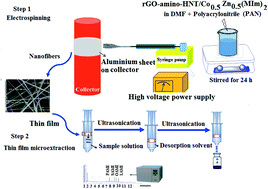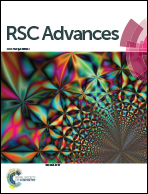The fabrication of a novel polyacrylonitrile/reduced graphene oxide-amino-halloysite/bimetallic metal–organic framework electrospun nanofiber adsorbent for the ultrasonic-assisted thin-film microextraction of fatty acid methyl esters in dairy products with gas chromatography-flame ionization detection†
Abstract
In this work, electrospun polyacrylonitrile/reduced graphene oxide-amino-halloysite/bimetallic metal–organic framework (PAN/rGO-amino-HNT/Co0.5Zn0.5(MeIm)2) nanofiber film was synthesized and investigated as a novel adsorbent for the ultrasonic-assisted thin-film microextraction (UA-TFME) of fatty acid methyl esters (FAMEs), including palmitic methyl ester (PAME), oleic methyl ester (OAME), stearic methyl ester (SAME), and linoleic methyl ester (LAME), from dairy products. The hybrid nanocomposite was obtained via bonding halloysite nanotubes to reduced graphene oxide, followed by loading with bimetallic metal–organic frameworks. The determination of FAMEs with nanofiber film was performed in two stages of desorption and absorption where, initially, the analytes were adsorbed onto the nanofiber film and then desorbed with organic solvent. In this study, ultrasound was used for both the adsorption and desorption stages. The advantages of ultrasonication are extensive, overcoming the shortcomings of conventional techniques in terms of energy consumption and solvent use, allowing a shorter treatment time with a low cost of implementation. Based on PAN/rGO-amino-HNT/Co0.5Zn0.5(MeIm)2 thin film, a microextraction-gas chromatography-flame ionization detection (TFME-GC-FID) method was developed. Experimental parameters affecting the extraction and desorption steps were optimized. The desorption parameters, including desorption time and the properties of the desorption solvent, were investigated one factor at a time. Then, effective parameters in the adsorption step were optimized using a Box–Behnken design and Design-Expert 7 software. Under the optimal conditions, the method detection limits (S/N = 3) were in the range of 0.03–0.06 μg L−1 and the limits of quantification (S/N = 10) were within 0.11–0.23 μg L−1. The relative standard deviations for intra-day and inter-day precision were 2.4–4.7% and 2.6–3.4%, respectively. In the present work, the UA-TFME method was successfully applied for the quantification of fatty acid methyl esters in dairy products (milk, yogurt, cheese, yogurt soda and butter samples) for the first time. The fatty acids were transesterified using standard procedures and were subjected to UA-TFME treatment prior to GC-FID determination. The developed method possesses the advantages of simplicity, rapidity, cost-effectiveness, sensitivity, and non-invasiveness.



 Please wait while we load your content...
Please wait while we load your content...